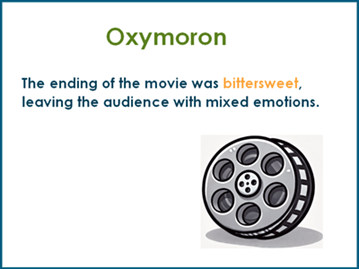Here are some steps and tips to effectively teach the concept of oxymoron.
Introduction to opposites
Start with a brief review of opposites since oxymorons rely on combining opposite or contradictory terms.
Activity: Create a list of common opposites (e.g., hot/cold, big/small) and have students match them.
Explain oxymorons
Introduce the concept of oxymorons, explaining that they are pairs of words that seem contradictory but are used together to create interesting effects.
Definition: Provide a simple definition, such as "An oxymoron is when two opposite words are put together to make a new meaning."
Examples of oxymorons
Provide some examples that are age-appropriate and easy to understand.
Examples: "Jumbo shrimp," "bittersweet," "deafening silence," "pretty ugly."

Discussion
Discuss why these examples are considered oxymorons and what makes them interesting or funny.
Question: Ask students why "jumbo shrimp" is an oxymoron and what they think it means.
Interactive activities
Engage students with activities to reinforce the concept.
Matching game: Create cards with individual words that can form oxymorons and have students pair them correctly.
Creative writing: Ask students to write sentences using oxymorons.
Art project: Have students draw pictures representing different oxymorons.
Group activity
Organize a group activity where students work together to find or create their own oxymorons.
Brainstorming: In small groups, students can brainstorm and share oxymorons they come up with.
Review and reinforce
Review the concept regularly to reinforce learning.
Quiz: Give a short quiz or worksheet with oxymoron-related questions.
Discussion: Encourage students to find oxymorons in books, movies, or everyday conversations and share them in class.
Use visual aids
Visual aids can help make the concept more tangible.
Charts and posters: Display charts or posters with common oxymorons and their meanings.
Multimedia: Use videos or songs that include oxymorons.
By making the learning process interactive, visual, and relevant to their everyday experiences, elementary school students will find it easier to understand and remember what oxymorons are.

